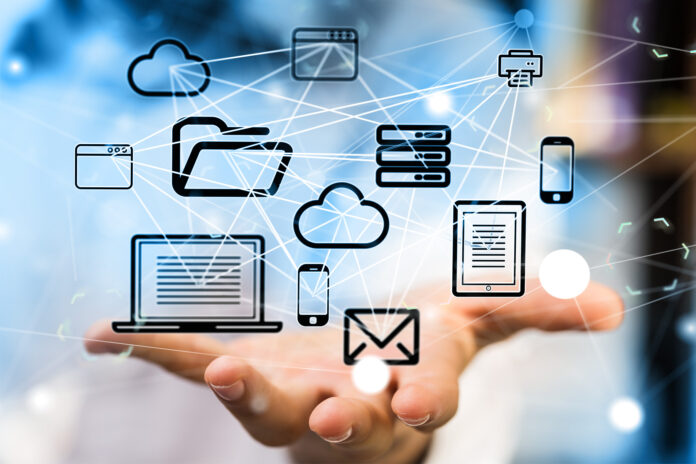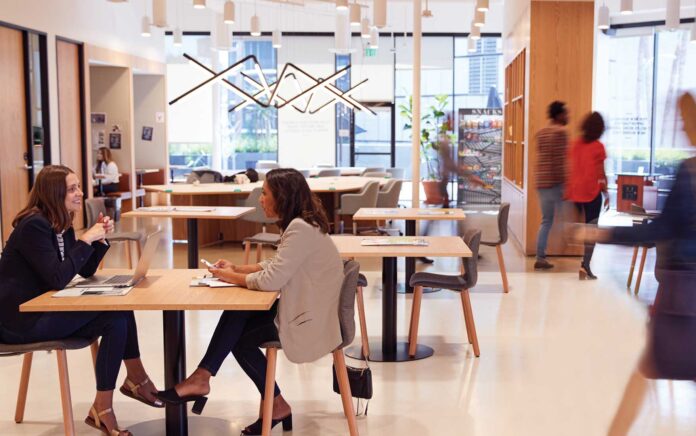When you imagine a modern workplace, what do you think of first? A game room or nap pods, perhaps? How about a space filled with a mixed bag of creatives and businesses working together in a common space?
While you are likely to find these examples across cities and companies, an even newer trend is surfacing to define the idea of a modern workplace.
These days, the modern workplace will still showcase the culture and overall sense of the organization, but it will also attract and retain employees through flexible environments and considerable work-life balance.

What is a modern workplace?
The details of a modern workplace keep evolving to meet the needs of present and future businesses and employees in a fast-moving world.
To be concise, a modern workplace is defined by three sets of conditions: physical, technological, and psychological. All three are aimed to help achieve employee satisfaction while optimizing the efficiency and productivity of the business.
To be more specific, any modern workplace is incomplete without smart software systems. The cornerstones are the HR and payroll systems. It has become imperative to have up-to-date systems that ensure employees are reliably and consistently paid on time and without delays. To learn more about seamless HR and payroll software systems and how they can benefit your organization, click here.
What makes a modern workplace effective?
Usually, modern workspaces are designed around a concept called activity-based working. This design seeks to integrate more open spaces with spaces previously set aside for other specific activities.

An activity-based workplace
Activity-based workplace models are more open than traditional office models. Open workstations, which essentially act as quiet places, leave the enclosed spaces to provide privacy. This type of workplace is dynamic and accessible.
Employees have the freedom to choose which area or place of the workplace best suits the tasks and activities they need to complete for the day. They can move around to break up the monotony. Smart designs can also cater to a variety of working styles. For instance, some employees may prefer a big table near a window. Others may prefer an isolated workstation to get in the zone. The same employee may mix it up throughout the day.
Flexibility helps with productivity
Flexibility plays a huge role in letting employees be fully productive. Flexibility can mean employees don’t have a designated desk or workstation. Instead, they can use a hot desk for a few hours of work on their laptop, and when they’re done, they can head to a private, soundproof booth to make phone calls.
This also means they can take meetings in pre-booked, designated spaces set up with all the tech requirements vital for an uninterrupted experience.
Employees also have the option to move on to a huddle room where they can collaborate with just a small group. This allows them to brainstorm without interrupting others.
An activity-based space is designed to help maximize flexibility and productivity while at the same time eliminating problems that occur frequently in open-plan designs.

Freedom to choose where, when, and how
With flexibility, employees have the freedom to decide where, when, and how to work throughout the day, enhancing engagement and effectiveness.
An activity-based workspace also serves recent trends of on-demand culture, where ever-changing needs can be met throughout the day. Last-minute conference calls, video chats, and custom tech setups are increasingly less like interruptions and more like expectations.
More than a physical space, the key to making it all work is the organizational culture immersed in it. The culture that creates this sort of workspace has demonstrated to employees that their preferences are being met.
Benefits and characteristics of the modern workplace
The modern workplace is increasingly becoming accepted as the most effective. What are some of the hallmarks? How does it work? And why?

It’s employee-centric
In the modern workplace, employee satisfaction and morale are highly valued and encouraged. Placing emphasis on truly humane approaches, from ergonomic, versatile spaces to daily work-life balance, leads to happier employees.
Happier employees drive superior performance, often resulting in increased production, amplified innovation, and cost reduction. Significantly, there’s also a decrease in turnover in employee-centric workspaces. Employees are more likely to become advocates who serve as ambassadors to bring in prospective talent.
The space to empathize
Empathy helps us identify, comprehend and experience another person’s pain points. In a modern workplace, sincere empathy can help to not only create a positive bond between management and employees but can also help to improve support, co-working relationships, and performance. Open work spaces help employees develop friendships and even partake in hobbies together. Team members are able to get to know each other on a more personal level. For example, employees can talk about their hobbies, families, favorite sports, etc. Open spaces encourage fun interactions and help determine shared interests. For example, if the majority of the team enjoys football, they can even start a football office pool using printable football squares from Doc’s. The best part is that everyone can participate. This is a great option for including everyone, even people who don’t know anything about football. Since it all comes down to the luck of the draw, all players have the same opportunity to win. Sharing hobbies with your colleagues helps strengthen bonds and breaks the monotonous work routine that most people are used to.
Countless studies demonstrate that an overwhelming majority of employees consider it vital for companies to express empathy. Yet many companies belittle this idea even as CEOs agree that empathy may help to enhance financial performance.
Companies that stimulate integrity and collaboration between employees make it easier to more freely discuss ideas.

The thirst for knowledge, learning, and self-development
There’s no end when it comes to education in the modern workplace. Education takes center stage for employees who seek modern workplaces. They are often lifelong learner personalities who value ongoing skill training and development.
Furthermore, we are in an unmatched era of technological progress squarely impacting the shifting employee market. According to one study done in 2018, researchers anticipated a loss of over 70 million jobs by the year 2024 because of automation and redundancy.
Chartered Management Institute’s (CMI) research has remarked that this number is likely to reach around 370 million by 2030, with artificial intelligence as another major contributing factor.
On the other hand, these same changes will create opportunities, with the potential to generate over 130 million new work positions by 2024. CMI also believes that almost 80 percent of potential jobs available in 2030 don’t even exist yet.
Working remotely
It’s no secret that remote working is now becoming more and more common.
Video conference apps, time tracking software like Time Doctor, mobile text platforms, cloud file management, and the quickly evolving world of collaborative technology have enabled people to co-work efficiently from practically anywhere in the world.
Reports and studies published by one software company in 2019 revealed that 60 percent of businesses already offer some level of remote working. The Bureau of Labor Statistics also released vital information that indicates over 70 percent of all divisions will offer remote work by 2028.
One of the main reasons for increasingly lofty projections? A flexible business environment brings advantages for management and employees. A flexible schedule and the chance to work remotely can increase job satisfaction, and put simply, happy employees stay longer.
Not to mention remote working helps minimize office expenditures.

A physical workplace
It’s not just working remotely that’s gaining popularity. Physical workplaces are going through elemental changes too. In a modern workplace, physical spaces are being customized to meet various needs and boost employee satisfaction.
As we touched on, employees are no longer subjected to work at a single workstation. Instead, they have the freedom to choose among a variety of spaces in an open-plan office. And depending on the nature of the task, employees may choose to work within small, casual sitting areas, video rooms, or workrooms.
Similarly, for tasks requiring a high level of concentration, employees have access to a quieter place. Interestingly, newer, more privileged companies are emphasizing office spaces built around nature to help improve creativity and create better experiences.
Initiatives that show an interest in transforming the physical workspace can help increase innovation, morale, and productivity while decreasing costs on the heels of versatility.
Power of collaboration
Since collaboration is a recurring theme in this article, most of the initiatives we’ve discussed so far regarding the development of a modern workspace are related to engagement and encouraging teamwork.
The reason for this is a simple one: Collaboration leads to productivity and efficiency. In the modern workspace, it has become the foundation of all things cultural, technological, and procedural, stimulating the employees to work together with unlimited access to shared data.
The basis of any true team collaboration is the process of generating creative ideas together frequently. It keeps employees on the same page, and it keeps them engaged, as anyone has the opportunity to contribute.

Final thoughts
The modern workspace continues to evolve with the times. The design is constantly improving, drawing more out of employees’ hard work, passion and drive.
No doubt adaptation will follow technological advances. And embracing those changes will accelerate organizations and businesses’ opportunities to recruit talent and new customers.
Have you worked in a modern workplace? How did or how would it help you to stay motivated and productive?





![Calgary’s Hottest Neighborhoods for Luxury Homebuyers [2024]](https://thewashingtonote.com/wp-content/uploads/2024/04/Calgary-324x160.png)



